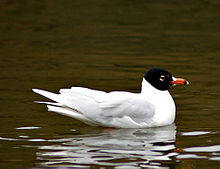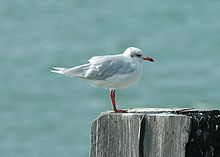- Mediterranean Gull
-
Mediterranean Gull 
Conservation status Scientific classification Kingdom: Animalia Phylum: Chordata Class: Aves Order: Charadriiformes Family: Laridae Genus: Ichthyaetus Species: I. melanocephalus Binomial name Ichthyaetus melanocephalus
(Temminck, 1820, coast of Adriatic Sea)Synonyms Larus melanocephalus
The Mediterranean Gull, Ichthyaetus melanocephalus, is a small gull which breeds almost entirely in Europe, mainly in the south east, especially around the Black Sea, and in central Turkey. There are colonies elsewhere in southern Europe, and this species has undergone a dramatic range expansion in recent decades. Birders often abbreviate its name to "Med Gull". As is the case with many gulls, it has traditionally been placed in the genus Larus.
It has colonised Britain, mainly in southern and eastern England with more than 90 pairs in 2000.
In winter, this bird migrates to Mediterranean and Atlantic coasts.
This gull breeds in colonies in large reedbeds or marshes, or on islands in lakes; where its population is small, it nests in Black-headed Gull colonies. Like most gulls, it is highly gregarious in winter, both when feeding or in evening roosts. It is not a pelagic species, and is rarely seen at sea far from coasts.
This species is 36-38 cm long with a 98-105 cm wingspan. It can be distinguished from the Black-headed Gulls with which it often associates by its slightly larger size, very pale grey plumage and thicker red bill. The summer adult has a black head; the bird's scientific name actually means "black-headed gull". The similar species Black-headed Gull actually has a chocolate-brown hood. Adults have no black in their wings. The hood is lost in winter, leaving just a streaked grey mask. Legs are red.
The Mediterranean Gull's feeding habits are much an opportunistic omnivore, eating fish, worms, scraps, insects, offal and carrion.
This bird takes two years to reach maturity. First year birds have a black terminal tail band and more black areas in the upperwings, but have pale underwings.
This is a noisy species, especially at colonies, with a nasal "yeah" call.
The Mediterranean Gull is one of the species to which the Agreement on the Conservation of African-Eurasian Migratory Waterbirds (AEWA) applies.
References
- BirdLife International (2004). Larus melanocephalus. 2006. IUCN Red List of Threatened Species. IUCN 2006. www.iucnredlist.org. Retrieved on 6 May 2006. Database entry includes justification for why this species is of least concern
- Pons J.M., Hassanin, A., and Crochet P.A.(2005). Phylogenetic relationships within the Laridae (Charadriiformes: Aves) inferred from mitochondrial markers. Molecular phylogenetics and evolution 37(3):686-699
Gulls (family: Laridae) Genus Larus Pacific Gull • Belcher's Gull • Olrog's Gull • Black-tailed Gull • Heermann's Gull • Common Gull (or Mew Gull) • Ring-billed Gull • California Gull • Great Black-backed Gull • Kelp Gull (or Cape Gull) • Glaucous-winged Gull • Western Gull • Yellow-footed Gull • Glaucous Gull • Iceland Gull • Kumlien's Gull • Thayer's Gull • European Herring Gull • Heuglin's Gull • American Herring Gull • Yellow-legged Gull • Caspian Gull • Vega Gull (or East Siberian Gull / Mongolian Gull) • Armenian Gull • Slaty-backed Gull • Lesser Black-backed GullIchthyaetus White-eyed Gull • Sooty Gull • Great Black-Headed Gull (or Pallas's Gull) • Audouin's Gull • Mediterranean Gull • Relict GullLeucophaeus Chroicocephalus Saundersilarus Hydrocoloeus Rhodostethia Rissa Pagophila Xema Creagrus Categories:- IUCN Red List least concern species
- Gulls
- Larus
- British Isles coastal fauna
Wikimedia Foundation. 2010.


